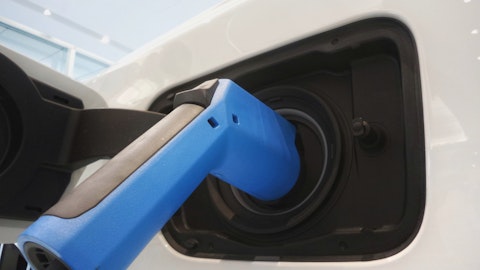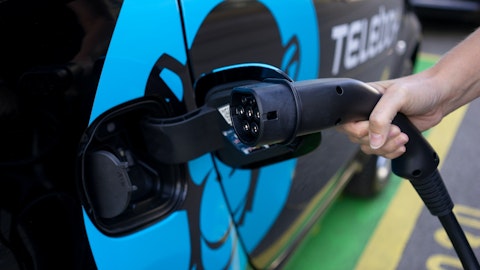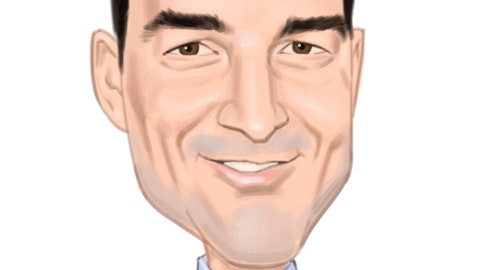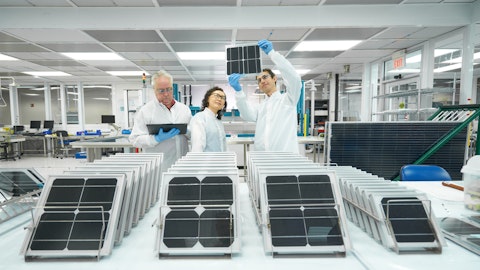DuPont de Nemours, Inc. (NYSE:DD) Q2 2023 Earnings Call Transcript August 2, 2023
DuPont de Nemours, Inc. beats earnings expectations. Reported EPS is $0.88, expectations were $0.83.
Operator: Thank you for standing by. My name is Sydney, and I will be your conference operator today. At this time, I would like to welcome everyone to the DuPont Second Quarter 2023 Earnings Call. All lines have been placed on mute to prevent any background noise. After the speakers’ remarks, there will be a question-and-answer session. [Operator Instructions] Thank you. Chris Mecray, you may now begin your conference.
Chris Mecray: Good morning. And thank you for joining us for DuPont’s second quarter 2023 financial results conference call. Joining me today are Ed Breen, Chief Executive Officer; and Lori Koch, Chief Financial Officer. We have prepared slides to supplement our remarks, which are posted on DuPont’s website under the Investor Relations tab and through the webcast link. Please read the forward-looking statement disclaimer contained in the slides. During this call, we will make forward-looking statements regarding our expectations or predictions about the future. Because these statements are based on current assumptions and factors that involve risks and uncertainties, our actual performance and results may differ materially from our forward-looking statements.

Tonhom1009/Shutterstock.com
Our Form 10-K, as updated by our current and periodic reports, includes detailed discussion of principal risks and uncertainties, which may cause such differences. Unless otherwise specified, all historical financial measures presented today are on a continuing operations basis and exclude significant items. We will also refer to other non-GAAP measures. A reconciliation to the most directly comparable GAAP financial measure is included in our press release and presentation materials that have been posted to DuPont’s Investor Relations website. I’ll now turn the call over to Ed.
Ed Breen: Good morning. And thank you for joining our second quarter 2023 financial review. This morning, we announced quarterly results with revenue and operating EBITDA better than our previously communicated guidance. This performance reflects our team’s ongoing strong execution, while facing continued volume pressure and consumer-driven end markets, mainly electronics. In the second quarter, organic revenue declined 4% versus the year ago period despite mid-teens organic declines from the Interconnect Solutions and Semiconductor lines of business within E&I. We continue to see broad demand strength in industrial end markets, including water, automotive, aerospace, as well as healthcare, along with continued carryover benefit of pricing actions taken last year to offset inflationary pressure.
Notably, operating EBITDA, operating EBITDA margin and adjusted EPS were all up sequentially from first quarter. After nearly a year long downturn, we also saw a sequential sales lift in Interconnect Solutions of 7%. We also continue to be proactive in taking additional actions within our control to minimize the impact of volume declines given near-term slowdown in select end markets, while also focusing on optimizing cash generation. Turning to Slide 4. We continue to advance a number of strategic priorities for accretive and value-added capital deployment. Yesterday, we announced completion of the Spectrum acquisition, a leader in critical specialty devices for healthcare end markets. This acquisition fully aligns with our strategic objectives of increasing topline growth through customer-driven innovation and expanding our Industrial Technologies growth pillar, while adding to our current offerings in the high-growth healthcare market.
Spectrum is being integrated into our Industrial Solutions line of business where it fits nicely with our existing Liveo franchise with annual sales of about $500 million, Spectrum together with Liveo and our Tyvek Healthcare Packaging business increases our total revenue in healthcare markets to about 10% of our portfolio with expected growth rates above the company average. Spectrum’s year-to-date performance has been solid, and we are pleased that operating results are in line with our deal model estimates, which include an estimated operating EBITDA margin of approximately 22%. We are excited by Spectrum’s complementary fit and specifically our ability to leverage incremental growth opportunities, including synergies from cross-selling and the complementary accounts new and faster product development and deeper design and co-development partnerships with OEMs. Further on M&A, we continue to make progress with our Delrin business divestiture and our expectation of closing this planned transaction around year-end 2023 remains unchanged.
There has been good interest in the asset to date. Regarding share repurchases, we expect we will complete the $3.25 billion accelerated share repurchase transaction launched last November within a month. We also intend to complete our remaining authorization through a new $2 billion ASR to be executed shortly thereafter. Regarding the water district settlement that was announced in June jointly with Chemours and Corteva, this settlement comprehensively covers PFAS-related claims of public water systems starting the vast majority of the US population. Our portion of the settlement is about $400 million, and we expect final approval about six months following preliminary approval, which we expect to receive shortly. Regarding broader capital allocation goals, yesterday’s closing of the Spectrum deal and the new $2 billion ASR essentially completes the deployment of excess cash remaining from the M&M divestiture last November.
Our current capitalization remains very sound. And as a reminder, we have no significant debt maturities until November 2025. We are comfortable with a net leverage point around 2x as an equilibrium target going forward. Before I turn it over to Lori to review our financial performance, let me add that we remain excited about the visible growth drivers enabled by our technical innovation teams and application engineers who are squarely focused on helping customers solve their most complex challenges. To name just a few, strong growth is expected in the semiconductor industry with the ongoing global investment in new fabs. Overall growth of the semiconductor industry is anticipated to be high single-digits over the coming five-year period. We have the leading materials that enable the next generation of advanced chip manufacturing and packaging, which includes significant technology and support from the emerging generative AI revolution.
Within water, we continue to drive growth in desalination and which order markets and then helping customers achieve their sustainability goals. Finally, our auto adhesives business is well positioned to continue to capture growth with its product offerings and electric vehicles. With that, I’ll turn it over to Lori.
Lori Koch: Thanks, Ed, and good morning. Our focus remains on operational excellence and strong execution, and we are pleased to have delivered financial results ahead of expectations despite volume pressure in some of our most profitable lines of business in electronics. Turning to our financial highlights on Slide 5. Second quarter net sales of $3.1 billion decreased 7% as reported and 4% on an organic basis versus the year ago period. Currency results in a 1% headwind from dollar strength against key currencies most notably the won and yen, and we also saw a 2% headwind related to portfolio changes. Breaking down the 4% organic sales decline, a 6% volume decline was partially offset by a 2% pricing gain reflecting continued carryover benefit of actions taken last year to offset broad-based inflation.
Volume decline primarily reflects continued demand weakness in consumer electronics coupled with inventory destocking across the channel and some softness, including destocking in North American construction related markets. Lower volume in these consumer turbine end markets was partially mitigated by continued strength in water, automotive, aerospace and healthcare markets. Volume within electronics and construction end markets during the quarter was down 15 the year ago period, while our remaining industrial-based businesses were up about 4%. From a regional perspective, Europe sales in the quarter were up 4% on an organic basis, while North America and Asia Pacific were down 3% and 8%, respectively versus the year ago period. China sales were down 14% on an organic basis, driven mainly by the electronics demand weakness, but increased sequentially versus the first quarter.
Second quarter operating EBITDA of $738 million decreased 11% versus the year ago period, driven by lower volumes and the impact of reduced production rates in electronics as we align inventory with demand. Operating EBITDA margin during the quarter of 23.9% was down 110 basis points versus the year ago period, driven by volume pressure, reduced production rates and mix headwinds in the high margin steady business. On a sequential basis, operating EBITDA and operating EBITDA margins were up from the first quarter. Decremental margins for the quarter was 40%, excluding the impact of absorption headwinds related to reduced production rates within electronics, decremental margin was below 20%, enabled by aggressive actions taken year-to-date to reduce discretionary spend.
Adjusted EPS in the quarter of $0.85 per share was down 3% versus last year, which I will detail shortly. Looking at cash performance. I would first like to highlight that we have made a reporting change effective with today’s second quarter results and are now providing cash flow disclosure separated between continuing and discontinued operations. This change is being made to improve visibility into cash flow generation and cash flow conversion of the ongoing businesses. On a continuing operations basis, cash flow from operations during the quarter of $400 million less CapEx of $123 million resulted in adjusted free cash flow of $277 million and associated conversion of 73%. This reflects significant improvement versus last year on a comparable basis, driven by lower inventory.
Adjusted free cash flow included a benefit of about $80 million in reduced inventory and a headwind of about $200 million related to interest payments. Optimizing cash flow continues to be a top priority for us. On adjusted free cash flow and conversion improved sequentially, we still have work to do to get to our target levels and expect further improvement in working capital metrics by year-end. Turning to Slide 6. Adjusted EPS for the quarter of $0.85 decreased 3% compared to $0.88 in the in the year ago period. Lower segment results more than offset below the line benefits, including a $0.19 benefit related to lower net interest expense and a lower share count. A higher tax rate and exchange loss during the quarter resulted in adjusted EPS headwind of $0.08 per share.
Our tax rate for the quarter was 23.7%, up from 22.6% in the year-ago period, driven primarily by geographic mix of earnings. Turning to segment results, beginning with E&I on Slide 7. E&I second quarter net sales of $1.3 billion decreased 14% and organic sales declined 12% due to lower volume, along with currency headwinds and an unfavorable portfolio impact of 1% each. At the line of business level, volume for Semiconductor Technologies decreased 19%, while Interconnect Solutions volume decreased 15% versus the year ago period. The decline in Semi Tech resulted from a continuation of lower semiconductor fab utilization rate due to weak end market demand as well as inventory de-stocking across the channel. Chip fab utilization rates in the second quarter averaged in the low 70s on a percentage basis.
The decline in Interconnect was driven by continued weak smartphones, PC and tablet demand along with channel inventory destocking. Our PCB customers in China offerings in the second quarter with utilization rates slightly improved from the mid-40s during the first quarter, which was a cycle low. The PCB market has been in a slowdown for a year now and we are beginning to see signs of improvement within our Interconnect business, illustrated by first and second quarter sequential growth of about 7% and with further expected sequential growth in the third quarter. Sales for Industrial Solutions were flat on an organic basis as pricing and ongoing strength in broad-based industrial markets were offset by lower demand in largely consumer-driven areas, such as advanced screening applications and those tied to electronics markets, including OLED display.
Operating EBITDA for E&I of $349 million was down versus the year ago period primarily due to volume declines and lower operating rates to better align inventory with demand, partially offset by reduced discretionary spend. Turning to Slide 8. W&P’s second quarter net sales of $1.5 billion were flat versus last year as organic sales growth of 1% was offset by a 1% currency headwinds. Organic growth of 1% reflects a 5% increase in price resulting from the carryover impact of pricing actions taken last year, mostly offset by a 4% decrease in segment volumes due to declines in shelf care solutions. At the line of business level, organic sales growth was led by Water Solutions, which was up mid-teens on continued demand growth for water filtration led by reverse osmosis and ion exchange resins, along with benefits from carryover pricing.
IT Solutions sales were up mid-single digits on an organic basis driven by carryover pricing and volume strength in Kevlar and Nomex with an aerospace and automotive market, especially for EVs, coupled with Tyvek strength in health care. Shelter Solutions were down 12% on an organic basis, driven by demand softness in construction markets as well as de-stocking, although we do expect a reduced impact from de-stocking in the second half. Operating EBITDA for W&P during the quarter were $368 million, up 6% or operating EBITDA margin of 24.6%, increased 140 basis points versus the year ago period. The improvement resulted primarily from net pricing gains and disciplined cost control, which more than offset volume declines. Turning to Slide 9, I will close with a few comments on our outlook and guidance for the third quarter and full year 2023.
Regarding the demand environment, we continue to expect fairly steady demand in most of our industrial end-markets within E&I and W&P although, we expect sales moderation in our Water business due to slower demand in China. Within Electronics, we saw stabilization and some early lift in our Interconnect Solutions business. The 7% sequential improvement in sales during the second quarter, and we expect mid-single-digit sequential growth to follow, in the third quarter. We believe, challenging markets likely bottom during the second quarter, and we assume net-net sales in the second half will improve slightly on a sequential basis. Given ongoing consumer electronics demand headwinds, notably in China, we have tempered the rate of second half growth to prior assumptions.
We are adjusting our full year 2023 guidance to account for the slower cadence of recovery in electronics, including our actions to continue to reduce production to align inventory with demand. In addition, our third quarter and full year guidance now includes the estimated contribution from Spectrum beginning August 1. For the full year, we now expect net sales to be between $12.45 billion and $12.55 billion, operating EBITDA to be between $2.975 billion and $3.025 billion and adjusted EPS to be between $3.40 and $3.50 per share. For the third quarter 2023, we expect revenue of approximately $3.15 billion, operating EBITDA of approximately $755 million and adjusted EPS of approximately $0.84 per share. With that, we are pleased to take your questions, and let me turn it back to the operator.
See also 12 Best Agriculture ETFs To Buy and 25 Second Date Ideas to Get You Laid – Guaranteed.
Q&A Session
Follow Dupont (Old Filings) (NYSE:DD)
Follow Dupont (Old Filings) (NYSE:DD)
Receive real-time insider trading and news alerts
Operator: [Operator Instructions] Your first question comes from the line of John McNulty from BMO Capital Markets. Your line is open.
Bhavesh Lodaya: Hi. Good morning. This is Bhavesh Lodaya for John. Maybe on the Water business, the Water business tends to be a bit less cyclical compared to your other businesses. Can you add some color on what is driving the softness in China? What changed there since maybe last quarter? And what kind of recovery do you expect maybe over the next couple of quarters?
Ed Breen: Yeah. We think the next couple of quarters or just a little bit later will be closed in China, and it’s really slowness in the industrial economy in China right now, which obviously should rebound here at some point, but we’re expecting that to be a little softer in the second half of the year that, by the way, that’s growth that we’ve had in that business is double-digit growth. So we’re just saying it’s going to moderate some still growth, but just slower growth in the second half of the year. But as that business has done quarter in, quarter out. It grows at a pretty nice clip, and I expect this China to improve some. That growth rate will pick up also. Remember, 70% of that business is a renewable business that’s steady. So I think a couple of quarters maybe a little later in China, is what we’re seeing.
Bhavesh Lodaya: Got it. And then in Electronics great to see the inflection coming in Interconnect Solutions, we have also seen some positive MSI data points. What are you hearing in semis technologies? Like, when do you expect an inflection there? And maybe any color on your order books for electronics that you’re seeing this quarter so far?
Ed Breen: Yeah. So just probably just back to the ICS one, that started to decline and destocking started about the middle of 2022. So it’s almost been kind of 10 months that in a downturn in the first quarter, it was really one at the bottomed. And then we did see 7% sequential pickup, and we’re expecting mid-single-digit pickup by the forecast we had for the third quarter. So obviously, that’s starting to come nicely off the bottom. The semi 1 is the one we tempered a little more in the second half. We look like we hit the bottom in the second quarter. We’re not gauging much upturn in the third quarter. Instead, we’re assuming we have another quarter kind of near the bottom are just very slightly up from that. And then we think somewhere the inflection point is more in the fourth quarter, but it’s hard to tell what month you actually see it.
So we did pick it up a little bit in the forecast in the fourth quarter, but not significantly. So that’s the thing we kind of tapped down when we gave you the guidance here today. But I think we’ve seen the bottom in semi, and we’re seeing the lift begin in ICS now. Remember, ICS is still negative. As a way to come back still, but it was down over 20%, and we’re starting to write it back. Those will still be negative in the third and fourth quarter on a year-over-year compare.
Bhavesh Lodaya: Appreciate the time. Thank you.
Ed Breen: Thank you.
Operator: Your next question comes from Christopher Parkinson from Mizuho Securities.
Christopher Parkinson: Great. Thank you, so much. If we could circle back very quickly to the ICS side, there’s been a bit of a difference between how China handset sales have been trending of late versus the rest of the Western world in terms of how to think about that I’d love some comments on how to think about that into the second half of the year, as well as you do have a few customers with some potential new launches in the second half. So just in terms of the normalization process, it would be very helpful to get some commentary on how to think about that as it turns more into the second half, but probably more importantly, even based on kind of the renewed, I’d say, much lower bar than we’ve seen in the past, let’s say, 1.5 years or so? Thank you.
Ed Breen: Yeah. Let me comment, and I’ll turn it to Lori by just – I don’t want to say customer names, but we’re in good shape this year on the new models being introduced by a couple of the large cell phone players. So from a market share standpoint, we know which phones we’re in, and we’re in a better position than we were last year, not that we were in a bad position at all last year. But we feel like we’re in a good position with the launch of the new models coming in. We know what we’re in, in those phones. And by way, clearly, one of the things I think you all know we’re in is the Kapton technology for the 5G antenna is a key component for us, along with some other components, but that’s a key one. Lori, do you want to just talk about the timing?
Lori Koch: Yeah. On the smartphone and broadly, the consumer electronics recovery. That was part of the revision that we had in the second half. So our original expectations on a full year basis for smartphones would be down about 1% and PCs down about 7%. We revised expectations on each of those end markets along with the industry forecast for smartphone sound to be more in the 5% range in PC is supposed to be low double digit. So – but that does embed year-over-year growth in the fourth quarter. So it sounds like one more quarter of year-over-year down in the third quarter and then recovery that’s worth into the more normal market and most likely setting up for a strong 2024, those markets are in maybe through the destock and returning to more of a normal demand in growth.




